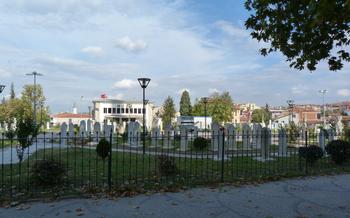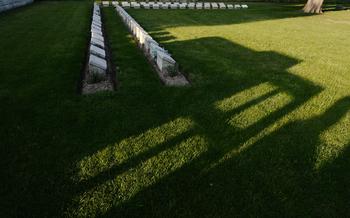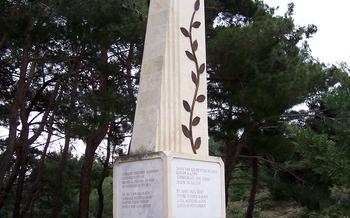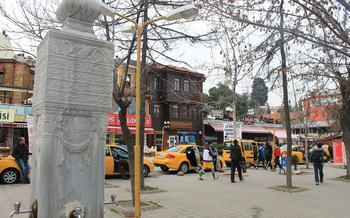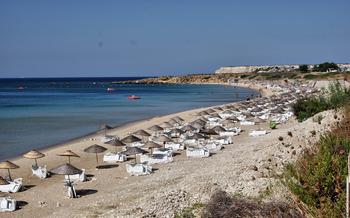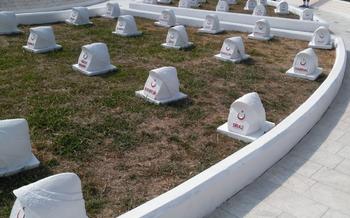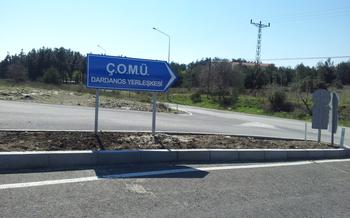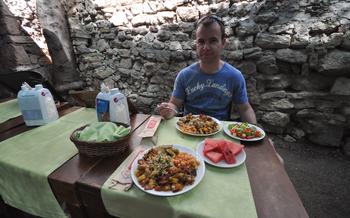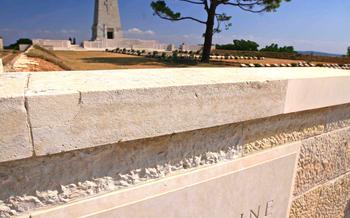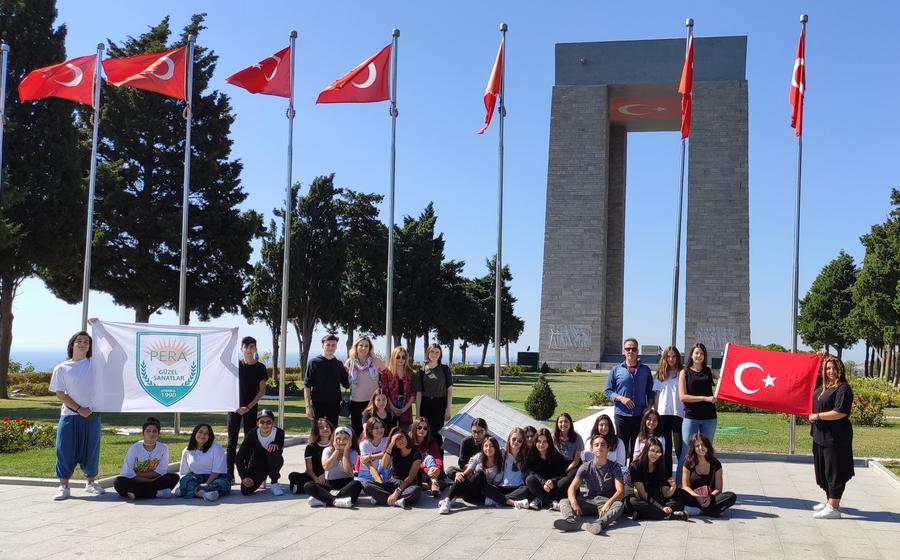
Gallipoli Peninsula Historical National Park
- Gallipoli Peninsula Historical National Park: A Place of Remembrance
- Exploring the Commemorative Sites
- The Beaches of Gallipoli
- Battlefield Trenches and Tunnels
- Memorials and Cemeteries
- ANZAC Commemorative Services
- Guided Tours
- The Gallipoli Museum
- War Correspondents Memorial
- Gallipoli Peninsula Visitor Information Center: A Hub of Guidance
- Respects to the Turkish Soldiers
- Transportation to Gallipoli:
- Accommodation Options
- Food and Dining
- Insider Tip
Gallipoli Peninsula Historical National Park: A Place of Remembrance
The Gallipoli Peninsula Historical National Park stands as a poignant reminder of the tragic events that unfolded during the Gallipoli Campaign of World War I. This revered site, located on the western coast of Turkey, bears witness to the fierce battles fought between the Allied forces, primarily comprising Australian and New Zealand troops (known as ANZACs), and the Ottoman Empire. The park encompasses a sprawling landscape of battlefields, commemorative sites, and tranquil beaches, encapsulating the profound historical significance of this hallowed ground.
The Gallipoli campaign, launched in April 1915, aimed to capture the strategically vital Dardanelles Strait, which served as the gateway to the Black Sea. However, the ambitious operation encountered staunch resistance from the Turkish forces, resulting in a protracted and bloody stalemate. The campaign ultimately ended in a tactical defeat for the Allies, but it left an enduring legacy of sacrifice, courage, and mateship.
The establishment of the Gallipoli Peninsula Historical National Park in 1973 marked a pivotal step in preserving and commemorating the memory of those who fought and fell on this sacred ground. The park serves as a living testament to the sacrifices made by both sides during the conflict and fosters a deep sense of respect and understanding among visitors.
Exploring the Commemorative Sites
The Gallipoli Peninsula Historical National Park encompasses a range of commemorative sites that pay tribute to the fallen soldiers and the significance of the Gallipoli campaign. These sites offer a poignant and immersive experience for visitors seeking to understand the history and legacy of this pivotal battle.
Anzac Cove: A Sacred Ground
Anzac Cove holds a profound significance as the landing site of the ANZAC forces on April 25, 19Today, it serves as a hallowed ground, commemorating the immense sacrifice and courage displayed by the soldiers who fought on these shores. The serene atmosphere, coupled with the panoramic views of the cove, creates a deeply moving experience for visitors.
Lone Pine Cemetery: A Place of Remembrance
Lone Pine Cemetery stands as a powerful tribute to the fallen soldiers of the Gallipoli campaign. This meticulously maintained cemetery is the final resting place for over 4,000 Australian and New Zealand soldiers. The rows of pristine white headstones, etched with the names of the fallen, evoke a sense of solemnity and respect.
Chunuk Bair: A Strategic Battleground
Chunuk Bair, a strategic hilltop overlooking the Dardanelles Strait, witnessed some of the most intense fighting during the Gallipoli campaign. Today, visitors can explore the well-preserved trenches and tunnels that were constructed by both sides during the battle. The site offers a tangible connection to the harsh realities of trench warfare and the immense sacrifices made by the soldiers.
The Nek: A Symbol of Futility
The Nek, a narrow ridge between Chunuk Bair and Russell's Top, became a symbol of the futility of war during the Gallipoli campaign. Repeated attempts by Allied forces to capture this strategic position resulted in devastating losses, with thousands of soldiers perishing in a matter of hours. The site now serves as a poignant reminder of the tragic consequences of war.
The Beaches of Gallipoli
The beaches of Gallipoli hold profound historical significance, having borne witness to the tragic events of the Gallipoli campaign. Anzac Cove, Brighton Beach, and Suvla Bay, once scenes of fierce battles, now exude a serene ambiance, their natural beauty serving as a poignant reminder of the sacrifice and loss that occurred on these shores.
ANZAC Cove stands as a sacred site, where the ANZAC forces first landed on April 25, 19Today, the cove emanates a tranquility that belies its tumultuous past, with crystal-clear waters lapping at the sandy shore. Visitors can immerse themselves in the serenity of the cove, reflecting on the bravery and resilience of the soldiers who fought here.
Brighton Beach, situated north of Anzac Cove, played a crucial role in the subsequent landings of British and French troops. The beach, once a battleground, has now transformed into a peaceful haven, inviting visitors to stroll along its shores and contemplate the events that unfolded here.
Suvla Bay, located further north, witnessed the final large-scale Allied offensive during the Gallipoli campaign. Despite the ambitious plans, the landing at Suvla Bay encountered fierce Turkish resistance, resulting in heavy casualties. Today, the bay offers a tranquil retreat, with its sandy shores and gentle waves providing a stark contrast to its tumultuous past.
When visiting these beaches, it is essential to maintain respectful behavior, honoring the memory of the fallen soldiers. Visitors are encouraged to take a moment of silence, reflecting on the sacrifices made during the Gallipoli campaign. The beaches of Gallipoli serve as a poignant reminder of the horrors of war and the importance of peace and reconciliation.
Battlefield Trenches and Tunnels
The Gallipoli Peninsula Historical National Park preserves the intricate network of trenches and tunnels that were crucial to the Gallipoli campaign. These fortifications, dug by both ANZAC and Turkish forces, provide a glimpse into the harsh realities of trench warfare. Visitors can explore the preserved trenches, gaining a deeper understanding of the soldiers' living conditions and the strategies employed during the campaign. The tunnels, some of which extend hundreds of meters underground, offer a unique perspective on the subterranean world of the soldiers, where they sought shelter, planned attacks, and endured the horrors of war. By exploring these trenches and tunnels, visitors can gain a profound appreciation for the courage and resilience of the soldiers who fought in this iconic campaign.
Memorials and Cemeteries
The Gallipoli Peninsula Historical National Park is home to several memorials and cemeteries that honor the fallen soldiers of both sides. These memorials serve as a solemn reminder of the human cost of war and provide a place for visitors to pay their respects.
The Lone Pine Cemetery is a particularly poignant site, containing the graves of over 6,000 Australian soldiers who died during the Battle of Lone Pine. The cemetery is beautifully maintained and offers stunning views of the surrounding landscape.
The Chunuk Bair Memorial commemorates the New Zealand soldiers who fought and died in the Battle of Chunuk Bair. The memorial is located on the summit of Chunuk Bair and offers panoramic views of the Gallipoli Peninsula.
The Nek Memorial commemorates the Australian and New Zealand soldiers who were killed in a disastrous attack on the Turkish positions at The Nek. The memorial is a simple but moving tribute to the courage and sacrifice of these soldiers.
Visitors to the Gallipoli Peninsula Historical National Park are encouraged to visit these memorials and cemeteries and pay their respects to the fallen soldiers. By doing so, we can help to ensure that their sacrifice is never forgotten.
ANZAC Commemorative Services
The annual ANZAC Day services held at Gallipoli Peninsula Historical National Park hold immense significance for Australians and New Zealanders. These services commemorate the sacrifices made by their soldiers during the Gallipoli campaign. Every April 25th, large gatherings of people from both countries, including descendants of the fallen soldiers, come together to pay their respects.
The dawn service, held at the crack of dawn on Anzac Cove, is a particularly poignant event. As the sun rises over the tranquil waters of the Aegean Sea, the names of the fallen are read aloud, echoing through the serene atmosphere. The Last Post and the Reveille, played by buglers, add to the emotional intensity of the service.
Respectful behavior is of utmost importance during these commemorative events. Attendees are encouraged to maintain silence, allowing for a solemn atmosphere of remembrance. The services provide an opportunity to honor the memory of those who fought and lost their lives in the Gallipoli campaign, fostering a deep sense of connection and gratitude.
Guided Tours
Exploring the Gallipoli Peninsula Historical National Park with a guided tour offers a wealth of benefits. Knowledgeable guides provide historical insights, personal stories, and context, enhancing your understanding of the Gallipoli campaign. Various tour options are available, catering to different preferences and budgets. Group tours allow you to share the experience with fellow travelers, while private tours offer a more personalized and in-depth exploration. Self-guided tours, using guidebooks or audio guides, provide flexibility and independence. Consider factors such as group size, duration, and cost when choosing a tour. A guided tour will elevate your experience and ensure you grasp the historical significance of this poignant site.
The Gallipoli Museum
The Gallipoli Museum stands as a poignant tribute to the sacrifices made by both sides during the Gallipoli campaign. Located in the heart of the Gallipoli Peninsula Historical National Park, this museum offers a comprehensive account of the campaign through its collection of artifacts, interactive displays, and historical exhibits.
As you step inside the museum, you'll be greeted by a somber atmosphere that sets the tone for the journey ahead. The galleries are meticulously designed to transport you back in time, providing insights into the motivations, experiences, and sacrifices of the soldiers who fought here.
Among the museum's most compelling artifacts are the personal belongings of the soldiers, including weapons, uniforms, and letters. These items offer a tangible connection to the individuals who lived and died on this fateful peninsula. Interactive displays further enhance the experience, allowing visitors to engage with maps, timelines, and multimedia presentations that bring the campaign to life.
The Gallipoli Museum also sheds light on the broader context of the campaign, examining its political and strategic implications. It explores the motivations of the Allied powers and the Ottoman Empire, as well as the impact of the campaign on the course of World War I.
By delving into the history and legacy of the Gallipoli campaign, the Gallipoli Museum serves as a powerful reminder of the human cost of war and the importance of reconciliation. It encourages visitors to reflect on the sacrifices made by all those involved and to promote understanding and peace.
War Correspondents Memorial
The War Correspondents Memorial, situated within the Gallipoli Peninsula Historical National Park, stands as a poignant tribute to the brave men and women who risked their lives to document the horrors of the Gallipoli campaign. These intrepid journalists, armed with pens and cameras, played a crucial role in bringing the realities of war to the world's attention.
The memorial, inaugurated in 1995, is a testament to the vital work of war correspondents. It features a bronze statue depicting a correspondent amidst the chaos of battle, capturing the essence of their courage and dedication. The surrounding panels bear the names of over 200 correspondents who covered the campaign, representing various nationalities and media outlets.
War correspondents faced immense challenges in Gallipoli. The harsh conditions, constant danger, and strict censorship imposed by both sides made their work incredibly difficult. Yet, they persevered, determined to convey the truth of what was happening on the peninsula. Their dispatches, photographs, and sketches provided invaluable insights into the human toll of war, shaping public opinion and contributing to the historical record.
The War Correspondents Memorial serves as a reminder of the importance of freedom of the press and the sacrifices made by those who strive to inform the public. It is a fitting tribute to the brave men and women who risked their lives to bring the story of Gallipoli to the world.
Gallipoli Peninsula Visitor Information Center: A Hub of Guidance
The Gallipoli Peninsula Visitor Information Center, strategically located in the heart of the peninsula, serves as an invaluable resource for visitors seeking a deeper understanding of the historical significance and practical aspects of their visit. This center provides a wealth of information, including detailed maps, informative brochures, and comprehensive historical accounts of the Gallipoli campaign. The knowledgeable and friendly staff is always ready to assist visitors with personalized guidance and recommendations, ensuring a fulfilling and enriching experience. Whether you're planning your itinerary, seeking insights into specific sites, or simply looking for transportation options, the Gallipoli Peninsula Visitor Information Center is an indispensable starting point for your journey through this hallowed ground.
Respects to the Turkish Soldiers
The Gallipoli Peninsula was not only a battlefield for the ANZAC forces but also for the Turkish soldiers who valiantly defended their homeland. Their sacrifices and bravery should not be forgotten. Visiting the Turkish memorials within the park, such as the Turkish 57th Regiment Memorial, allows you to pay tribute to their fallen soldiers and gain a deeper understanding of their perspective. The historical context of the Gallipoli campaign highlights the complexities of the conflict and the shared suffering of both sides. By acknowledging and respecting the Turkish perspective, we promote reconciliation, understanding, and a more comprehensive understanding of this pivotal historical event.
Transportation to Gallipoli:
Getting to the Gallipoli Peninsula is relatively easy, with several transportation options available. The most popular route is by ferry from Eceabat, a town just across the Dardanelles Strait from Çanakkale. Ferries depart frequently throughout the day, and the journey takes around 20 minutes. From Çanakkale, you can also drive to Gallipoli, which takes approximately 45 minutes. If you are driving from Istanbul or other major cities in Turkey, follow the signs to Çanakkale and then to Gallipoli. Alternatively, you can book an organized tour that includes transportation to and from Gallipoli. This option is convenient and hassle-free, as the tour operator will take care of all the logistics.
Accommodation Options
When planning your visit to the Gallipoli Peninsula Historical National Park, various accommodation options are available to suit different budgets and preferences. In the town of Çanakkale, just across the Dardanelles Strait, you'll find a range of hotels offering comfortable stays. From budget-friendly options to luxurious accommodations with stunning views, there's something for every traveler.
For those seeking a more immersive experience, camping facilities are available within the park itself. These campsites offer a unique opportunity to connect with the natural surroundings and immerse yourself in the historical atmosphere. However, it's important to note that these facilities are basic and may not be suitable for everyone.
During the peak season, from April to October, accommodation in Çanakkale can be in high demand. To avoid disappointment, booking your stay in advance is highly recommended. This will ensure you have a comfortable place to rest and recharge after a day of exploring the historical sites.
When choosing your accommodation, consider factors such as your budget, desired level of comfort, and proximity to the park. Whether you prefer the convenience of a hotel in Çanakkale or the rustic charm of camping within the park, there's an option that will meet your needs.
Food and Dining
The options are limited within the Gallipoli Peninsula Historical National Park, so exploring Canakkale for a wider variety of cafes and restaurants is recommended. Indulge in the flavors of traditional Turkish cuisine, savoring dishes that have been passed down through generations. For a more intimate experience, consider packing a picnic lunch and selecting one of the designated picnic spots within the park. Enjoy a leisurely meal surrounded by the tranquil ambiance of nature, while honoring the memory of those who fought and fell in this historic place. Plan your meals carefully, as there are limited food options available within the park itself and bringing your own snacks and water is highly recommended.
Insider Tip
To make the most of your visit to the Gallipoli Peninsula Historical National Park, keep these insider tips in mind:
-
Timing your visit: The midday heat can be intense, especially during the summer months. Plan your visit for the morning or late afternoon to avoid the hottest part of the day.
-
Comfortable shoes: The terrain in the park is uneven, and there's a lot of walking involved. Wear comfortable shoes with good support to ensure a pleasant experience.
-
Pack the essentials: The sun can be relentless, so bring sunscreen, a hat, and plenty of water to stay hydrated.
-
Respect the solemnity: Remember that this is a place of remembrance and respect. Maintain silence and refrain from loud conversations or disruptive behavior.
